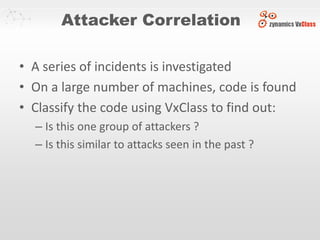VxClass for Incident Response
- 1. VxClass for Incident Response zynamics info@zynamics.com
- 2. Introduction ŌĆó Binary code is often left behind by attackers ŌĆō Running processes ŌĆō Dropped executables ŌĆō Kernel memory snapshots ŌĆō Network traffic ŌĆō Crash dumps
- 3. Introduction ŌĆó Useful evidence but difficult to analyze ŌĆó Current methods: ŌĆō Use AV scanner ŌĆō Run executable to provoke/observe behavior ŌĆō Remove packer/obfuscator code ŌĆō Manual analysis using IDA Pro
- 4. Current Methods ŌĆó Error-prone and time-consuming ŌĆó AV signatures are brittle, out of date ŌĆó Behavior can be difficult to provoke ŌĆó Removal of protection code is difficult ŌĆó Manual analysis ŌĆō Does not scale ŌĆō No easy correlation of results
- 5. VxClass ŌĆó Structural malware classification tool ŌĆó Categorizes malware samples into families ŌĆó Groups malware that shares code ŌĆó Allows correlation between samples ŌĆō Regardless of how they were obtained
- 6. VxClass ŌĆó Upload of samples through a web server ŌĆó Generic unpacking through emulation ŌĆó Extraction of structural information ŌĆó Comparison with known samples ŌĆó Storage of the results in a SQL database ŌĆó Visualization of the results in the browser
- 7. Uploading ŌĆó Upload samples ŌĆō Through a web interface in your browser ŌĆō Through XML-RPC ŌĆō User-based access control to samples: ŌĆó Public: All users can see and download ŌĆó Limited: All users can see, but not download ŌĆó Private: Only original uploader can see and download
- 9. Unpacking ŌĆó Generic unpacking is difficult ŌĆō Anti-debugging tricks ŌĆō Attempts to foil emulators ŌĆō Creation of and interaction between multiple processes ŌĆō Code obfuscation
- 10. Unpacking ŌĆó Our approach: Full system emulation ŌĆó Emulated Windows XP SP2 in Bochs ŌĆó Run the executable until it looks unpacked ŌĆó Aquire memory of all processes and dirty kernel pages ŌĆó Use code in aquired memory for classification
- 11. Unpacking ŌĆó Solved problems ŌĆō Anti-Debugging tricks ŌĆō Legacy API calls ŌĆō Multiple processes ŌĆō Interprocess communication ŌĆō Kernel memory analysis ŌĆó Result: Most packers can be unpacked automatically
- 12. Comparison ŌĆó Problem: Meaningful comparison of binary code ŌĆó Byte-by-byte comparison is useless ŌĆó Our approach: Structural comparison ŌĆō Award-winning (German IT-Security Award 2006) ŌĆō Uses industry-standard BinDiff engine ŌĆō Uses patent-pending MD-Index (more later)
- 13. Structural Comparison ŌĆó Extract call graph and flow graph information from samples ŌĆó Compare the structure of these graphs instead of byte sequences ŌĆó Compares code derived from same source ŌĆō Regardless of compiler settings ŌĆō Regardless of compiler
- 17. MD-Index ŌĆó Patent-pending ŌĆó Clever hash function for directed graphs ŌĆó Assigns 80-bit value to a directed graph ŌĆō Allows keeping a database of flow graphs ŌĆō Allows efficient queries into the database ŌĆó Is used within VxClass for several purposes: ŌĆō Very fast approximate comparison ŌĆō Code search
- 18. Results ŌĆó Memory dumps and recovered strings ŌĆó IDA files (IDB) of the resulting disassemblies ŌĆó Pairwise similarity scores ŌĆó Visualisation: ŌĆō Family trees ŌĆō Top-10-most-similar list
- 19. Results
- 20. Results
- 21. Results
- 22. Architecture Automated Upload Manual Upload Malware XMLRPC-Server Web-Interface SQL Database Distributed Workers Unpacker Disassembly Classifier MD-Index Bochs IDA BinDiff
- 23. Case Studies ŌĆó Noise reduction ŌĆō Automatically filter uninteresting samples ŌĆó Knowledge management ŌĆō Share information between analysts ŌĆó Attacker Correlation ŌĆō Is a set of attacks performed with one toolset ŌĆó Code searching ŌĆō Find certain functions in known samples
- 24. Noise Reduction ŌĆó Upload new files to the system ŌĆó How similar are they to interesting samples ? ŌĆō Comparison to database of known samples ŌĆó Prioritize accordingly
- 25. Knowledge management ŌĆó Each analyst uploads samples he knows to VxClass ŌĆó New malware comes in, gets uploaded ŌĆó VxClass determines which known samples this is similar to ŌĆó The expert for similar samples can be found
- 26. Attacker Correlation ŌĆó A series of incidents is investigated ŌĆó On a large number of machines, code is found ŌĆó Classify the code using VxClass to find out: ŌĆō Is this one group of attackers ? ŌĆō Is this similar to attacks seen in the past ?
- 27. Code Searching ŌĆó A particularly strange piece of code (just one function) is identified ŌĆō Perhaps a strange encryption function ŌĆó Does this particular piece of code appear in other samples in the database ? ŌĆó Search is not byte-based, but flow graph based (MD-Index) ŌĆó The answer is one click away
- 28. Performance ŌĆó One VxClass machine ŌĆō 800-1600 samples per day ŌĆó Performance depends on ŌĆō Obfuscation complexity ŌĆō Size of the malware ŌĆō Size of the database ŌĆó Can be fully parallelized ŌĆō The only bottleneck is the central database
- 29. Behavioral Analysis ŌĆó VxClass is not a behavioral-analysis tool ŌĆó VxClass is complementary to such tools ŌĆó We recommend combining VxClass with behavior-monitoring tools such as ŌĆō CWSandbox (http://www.cwsandbox.org) ŌĆō Anubis (Free) (http://anubis.iseclabs.org)
- 30. VxClass Options ŌĆó VxClass on a single machine ŌĆō Run it inside your organisation ŌĆó VxClass distributed ŌĆō Scale it to your needs ŌĆó VxClass as service ŌĆō We host a machine for you ŌĆó VxClass as shared service ŌĆō We host a machine for you ŌĆō Multiple clients use a shared database
- 31. Existing Customers ŌĆó The German BSI ŌĆō Agency for security in information systems ŌĆó Vodafone Germany ŌĆō Pre-filters Symbian/ARM executables ŌĆó Other government entities and private companies ŌĆó Mostly used for attacker correlation and noise filtering
- 32. Limitations ŌĆó Heavy obfuscation of control flow ŌĆó Virtualizing packers ŌĆó Unpacking only works on 32-bit Windows ŌĆō No Linux / OSX / Mobile unpacking ŌĆō 64 bit support is in the works ŌĆó Upload of IDBs allows heavy manual intervention beforehand
- 33. FAQ ŌĆó What OS does it run on ? ŌĆō It runs on a 64-bit Debian Lenny install ŌĆó Does it have any network dependencies ? ŌĆō No ŌĆó How can we extend the system ? ŌĆō All generated data is accessible through XML-RPC ŌĆō If needed, direct access to the SQL can be used ŌĆō The SQL schema is available on request


































